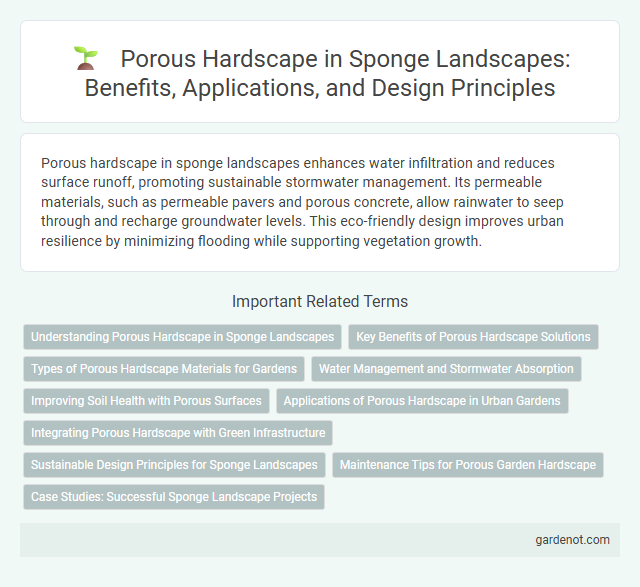Porous hardscape in sponge landscapes enhances water infiltration and reduces surface runoff, promoting sustainable stormwater management. Its permeable materials, such as permeable pavers and porous concrete, allow rainwater to seep through and recharge groundwater levels. This eco-friendly design improves urban resilience by minimizing flooding while supporting vegetation growth.
Understanding Porous Hardscape in Sponge Landscapes
Porous hardscape materials in sponge landscapes enable effective stormwater infiltration by allowing water to pass through surfaces like permeable concrete, porous asphalt, and interlocking pavers. These materials reduce runoff, minimize flooding, and promote groundwater recharge, enhancing urban resilience to heavy rainfall. Proper installation and maintenance of porous hardscape are essential to maintain permeability and ensure long-term performance in sustainable landscape design.
Key Benefits of Porous Hardscape Solutions
Porous hardscape solutions significantly reduce stormwater runoff by allowing water to infiltrate the ground, enhancing groundwater recharge and mitigating flood risks. These systems improve water quality by filtering pollutants through permeable surfaces, supporting sustainable urban drainage and reducing erosion. Their durability and low maintenance requirements make porous pavements an eco-friendly and cost-effective choice for resilient landscape design.
Types of Porous Hardscape Materials for Gardens
Porous hardscape materials for gardens include permeable pavers, gravel, and porous concrete, which facilitate water infiltration and reduce runoff. Permeable pavers, made from concrete or brick, offer durability and design versatility while allowing rainwater to seep through joints. Gravel beds provide excellent drainage and are cost-effective, whereas porous concrete combines the strength of traditional concrete with permeability to support sustainable landscaping.
Water Management and Stormwater Absorption
Porous hardscape materials like permeable pavers and porous concrete play a crucial role in effective water management by allowing stormwater to infiltrate the ground, reducing runoff and preventing flooding. These landscapes facilitate natural groundwater recharge and minimize surface erosion by controlling the flow and retention of rainwater. Implementing sponge landscape principles enhances urban resilience against stormwater challenges while promoting sustainable water absorption solutions.
Improving Soil Health with Porous Surfaces
Porous hardscape materials enhance sponge landscapes by allowing water to infiltrate and replenish soil moisture, reducing runoff and erosion. These surfaces support microbial activity and nutrient cycling, which are essential for improving soil health and fostering plant growth. Integrating porous pavements and pavers in urban designs promotes sustainable water management and long-term ecosystem resilience.
Applications of Porous Hardscape in Urban Gardens
Porous hardscape materials enhance urban gardens by improving water infiltration and reducing runoff, crucial for managing stormwater in densely built environments. These surfaces support sustainable landscaping by promoting groundwater recharge and minimizing erosion around plant beds and pathways. Integrating porous pavements and permeable pavers optimizes urban garden health and resilience against flooding.
Integrating Porous Hardscape with Green Infrastructure
Integrating porous hardscape with green infrastructure enhances urban stormwater management by allowing water infiltration and reducing surface runoff. Porous pavements, permeable concrete, and engineered surfaces facilitate natural groundwater recharge while supporting vegetation growth within green infrastructure systems. This combination improves water quality, mitigates urban heat island effects, and promotes sustainable landscape resilience in sponge city designs.
Sustainable Design Principles for Sponge Landscapes
Porous hardscape materials enhance sponge landscape performance by promoting groundwater recharge and reducing surface runoff. Integrating permeable pavers and porous concrete supports sustainable urban drainage systems, aligning with green infrastructure principles. These designs improve water quality while mitigating urban heat island effects and surface flooding.
Maintenance Tips for Porous Garden Hardscape
Maintaining porous garden hardscape involves regular cleaning to prevent debris buildup that can obstruct water infiltration. Use a gentle pressure wash or a stiff broom to remove dirt and organic matter while preserving the material's permeability. Inspect and refill joints with appropriate permeable materials like decomposed granite or gravel to maintain structural integrity and drainage efficiency.
Case Studies: Successful Sponge Landscape Projects
Case studies of porous hardscape in sponge landscape projects demonstrate significant improvements in stormwater management, reducing urban flooding by up to 40%. Successful implementations include permeable pavements and porous concrete that enhance groundwater recharge while minimizing runoff pollutants. These projects highlight the integration of sustainable urban drainage systems (SUDS) that balance ecological benefits with functional urban design.
Porous hardscape Infographic

 gardenot.com
gardenot.com